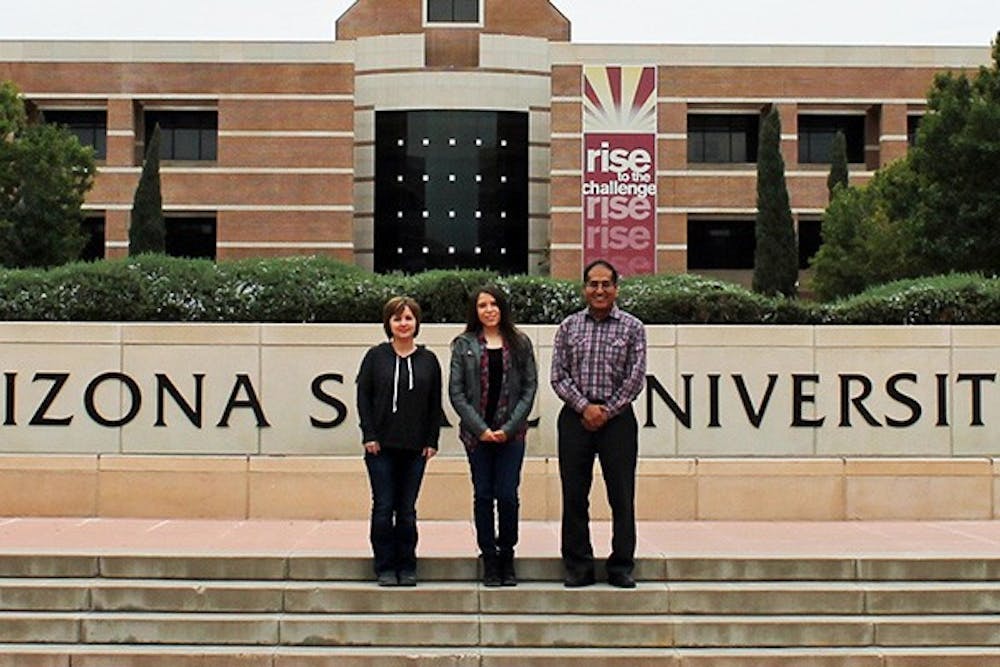 Tara Tucker, Lisa Tsosie and Dr. Yasin Silva (right to left) worked together to create a cyberbullying detection app called BullyBlocker. (Photo Courtesy of Dr. Yasin Silva)
Tara Tucker, Lisa Tsosie and Dr. Yasin Silva (right to left) worked together to create a cyberbullying detection app called BullyBlocker. (Photo Courtesy of Dr. Yasin Silva)After beginning the project in August 2012, a team of students and a professor are finally close to completing the cyberbullying detection app BullyBlocker.
Yasin Silva, who teaches applied computing and is part of the project, said the group is excited for completion, because it means BullyBlocker can be implemented for its true purpose: protecting youth from the pain of cyberbullying.
“It’s been great for the students to use their computing skills,” he said. “I think everyone is not only excited about the technical part … but they are also happy about building something that has the potential to save lives.”
Silva said he was inspired to take up the project after seeing a disturbing trend of children taking their lives after being cyberbullied, and that he felt society had not yet provided strong tools to solve the problem.
“My background is in computer science, so I’m not an expert in psychology … but after hearing all this news, I thought and asked myself, 'Is there really something that we could do?'” he said. “I think I saw the need of something, an app, a specific tool that parents could use.”
Once downloaded, the BullyBlocker app will collect data from a child’s activity on Facebook to monitor it for potential acts of cyberbullying. Using a complex system of analysis involving keywords and user responses, the app then computes a bullying rank, or a number from 0-100 that indicates the probability that the child is being cyberbullied, and sends it to the parents.
The application also takes into account indicators of vulnerability based on psychological studies, such as if the child has recently moved or has a disability.
Silva said the team chose Facebook for the BullyBlocker application because of its popularity and its technical aspects, though he hopes his group’s project will someday be expanded into other areas of technology.
“Most of the research and the design of the app can also be applied to any other site,” he said. “In some ways, we see this as a starting point. Maybe once we prove this can actually be useful in practice, we will implement this on other sites.”
The group was selected by ASU’s new crowdfunding project, a partnership between the Office of Knowledge Enterprise Development and ASU's Foundation for A New American University, designed to raise money for research initiatives. The project effectively reaches public audiences in order to ask for donations, and the BullyBlocker group had a goal of $10,000 for new equipment and personnel to aid in the implementation stage of the app. However, their site only raised a little over $3,000.
Despite this shortcoming, Silva said he’s still grateful for the project as it had unexpected outcomes.
“It has been a great experience for us, because even though we are not meeting our initial goal in terms of funding, what we did get was a lot of media attention,” he said. “People are talking about the problem of cyberbullying and complete solutions. People are going to start thinking, 'What else can we do about it?'”
Silva said he was also excited by media attention brought to the West campus, where the BullyBlocker project is primarily located.
“When people talk about ASU, most people assume they’re talking about ASU Tempe, but now actually TV people from different channels are coming to ASU West, many for the first time,” he said. “It brings the message to the public that we do research (and) that we’re trying to address public problems.”
Once Silva decided to undertake the problem of cyberbullying, he approached applied computing junior Lisa Tsosie, who he said shared his enthusiasm for making social change through computer science. She said the BullyBlocker app should be free to download because the safety of a child is priceless, though this will require outside support.
“It should be free, so it can be available to any parent or any child,” Tsosie said. “Depending on the resources we use, it may not be free, which is why we need help from the community.”
Tsosie said the hardest part of the project was the unpredictability of the technical obstacles they would face because BullyBlocker is the first application of its kind.
“When we first started the app, we didn’t really know what to expect,” she said. “That kind of uncertainty of not knowing what exactly we were going to face was challenging, but I don’t really feel like the challenges that I’ve faced discourage me from being a member.”
Although the team’s project is approaching its end, with a tentative completion time of fall 2014, Tsosie said this is the most crucial time for supporters to aid the team as it works on implementation and public distribution.
“If (individuals) like the BullyBlocker Facebook page, they can keep up with our project, and even share what we post on our page with their extended network,” she said. “We’d appreciate that too, to raise awareness, more visibility. And hopefully more people can find out about us and decide if they want to support us or not, so it helps us earn support — much-needed support.”
Across the nation in Florida, a Pasco-Hernando Community College student named Sarah Ball created a project called Unbreakable. For her project, she singlehandedly travels to schools to raise awareness about cyberbullying and mentor her peers to be responsible with technology.
Ball was cyberbullied by her best friend and ex-boyfriend in spring 2011.
“Being cyberbullied is very traumatic,” she said. “It’s emotionally draining as well as damaging. … They would tell me I was a lost cause, and that I was good-for-nothing, and that I didn't have a place. I definitely felt very worthless.”
Ball said one of the major issues with cyberbullying is often the child’s unwillingness to tell their parents, something the BullyBlocker project is trying to address.
She said she supports ASU’s BullyBlocker project, though she said it should be seen as a first step for a complex issue.
“I’ve talked to parents that said they have no idea how to detect and protect their child, and I think this is a really good way to get involved,” she said. “When I was bullied, I didn’t tell my parents it was happening. … (But) I think bullying is a great factor, and it takes a lot to strip away pieces of it.”
Ball said that if her parents had access to an app like BullyBlocker, the bullying would have likely stopped sooner, making it easier to heal.
“It almost breaks you down, and then you have to rebuild yourself in a way,” she said. “That’s what I did. I was very torn apart, and then I had to learn to build myself back up to be better than I was before. ... If I had this app when this was happening, I don’t think I would be as damaged as I was.”
She said the most important part of being cyberbullied is being able to come back from it and connect with others afterwards. Being able to trust others, like trusting parents with the BullyBlocker app, is difficult, she said, though it’s necessary for recovery.
“As a victim, it was hard for me to learn this, to trust people again,” she said. “Learning that you are much stronger than what other people say you are, not everyone is the person that bullied you. It’s OK to have faith in people and trust people, as long as they're the right people.”
Reach the reporter at elmahone@asu.edu or follow her on Twitter @mahoneysthename




